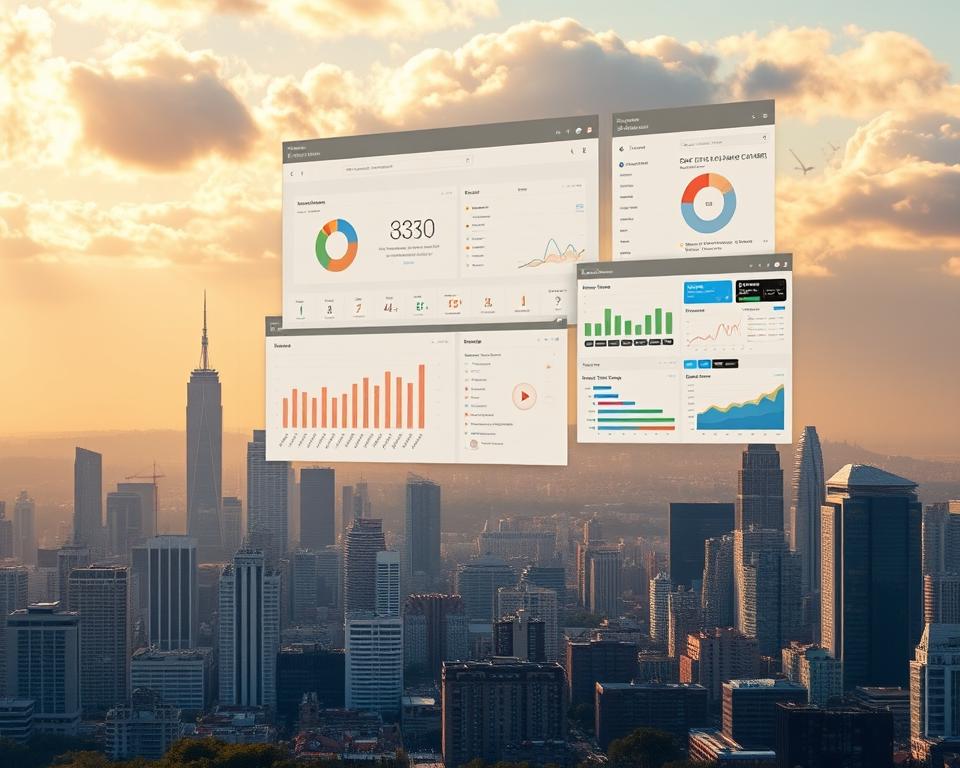The Transformation of Progression of Digital Marketing: An Odyssey
Have you heard that more than 170 million individuals consistently utilize social platforms, effectively altering the advertising environment? As buyers progressively transition to digital platforms, online marketing has surfaced as a pivotal strategy. It allows companies to engage audiences on channels where they dedicate a considerable part of their time. This transition signifies the transformation of digital marketing evolving from traditional practices to a more dynamic and participatory strategy.
With an approximate online advertising market worth of around $200 billion, it’s apparent that Joliet Digital Marketing Company must adjust to the current online marketing trends. This is crucial to stay competitive in this rapidly changing environment.
The increase of digital channels has allowed businesses to reach customers that traditional marketing methods struggle to target. It’s no longer required when a simple advertisement in a periodical would meet the need. Currently, focused marketing approaches have become prominent, employing methods like SEO strategies, social media platforms, and collaborations with influencers.
As we investigate the evolution of online marketing, we will delve into major milestones and trends. These have molded the existing marketing framework. We will showcase the unique opportunities and challenges faced by businesses in this digital age.
Essential Insights
- Over one hundred seventy million individuals actively engage on digital platforms, establishing vast promotional opportunities.
- Digital marketing is to be cheaper than classic approaches, facilitating wider reach with lower budgets.
- The global digital advertising market is forecasted to hit $517 billion by the close of 2023.
- Focused strategies like SEO boost online visibility and engagement for companies.
- Influencers have established a one billion dollar market, changing brand promotion.
- Organizations employing mobile advertising strategies can leverage the growing consumer trust on smartphones.
- Investing in digital marketing tools, like Google Ads, allows for accurate targeting based on demographic data.
Overview of Digital Marketing
Digital marketing encompasses a variety of advertising activities across various online platforms. This encompasses social networks, email, search engines, and online sites. It’s a essential aspect of contemporary marketing, given the rising online engagement between consumers and brands. Businesses that grasp the basics of digital marketing can craft approaches that effectively engage with their target audiences.
The evolution of internet marketing is powered by evolving buyer behaviors. The emergence of mobile technology has revolutionized marketing and sales. Today, companies utilize integrated strategies to address the needs of users who utilize multiple devices and platforms. Given the attention span of Generation Y and Gen Z, content must be captivating and impactful from the onset. Findings show that including video can increase message impact by up to triple.
The increasing significance of digital marketing underscores the necessity to stay abreast of emerging trends and technologies. Resources like AI-driven chatbots facilitate deep customer interaction, while digital influencers assist build trust with consumers. Traditional marketing methods are no longer adequate, emphasizing the significance of integrated digital strategies that satisfy today’s customer demands.
| Factor | Information |
|---|---|
| Buyer Behavior | Move towards online engagement, shorter attention spans (twelve seconds for Generation Y, eight seconds for Gen Z) |
| Technology Usage | Rise of smartphones, increase in engaging technologies |
| Promotional Strategies | Concentration on omni-channel and influencer marketing |
| Interaction Tools | Utilizing artificial intelligence chatbots and video materials in campaigns |
| Market Evolution | Increase in online advertising after 2000, emergence of pay-per-click (PPC) advertising with platforms such as Google AdWords |
What is Digital Marketing?
Digital marketing entails a array of approaches to connect with consumers through digital platforms. It includes SEO strategies, content creation, and social media engagement. The primary goal is to successfully reach and connect with audiences using vast data and advanced technologies.
The growth of digital advertising has been significant in the last few years. As organizations delve deeper into the digital realm, the need for effective online marketing tools grows. For instance, 53% of all internet traffic comes from natural search results, showcasing SEO’s importance in boosting visibility and visitor traffic.
Content marketing innovations are essential to a brand’s engagement with potential clients. The content marketing sector is projected to reach two trillion dollars by 2032. It’s vital for companies to adjust their approaches to effectively utilize these initiatives. Captivating content establishes connections, enhancing brand allegiance and awareness.
Moreover, the importance of robust CRM tools has increased. Companies that utilize customer insights can craft precision marketing campaigns. This causes better engagement and sales conversions.
In closing, online marketing is a constantly changing power for businesses looking to boost their digital presence. By adopting the latest in online advertising and cutting-edge content marketing, businesses can enhance visibility and drive higher audience engagement.
Progression of Digital Marketing
The advertising landscape has experienced a substantial change over the time. The evolution of digital marketing showcases how the web has altered business communication with customers. As traditional methods shifted obsolete, online platforms surfaced, offering fresh approaches to interact with consumers and track outcomes.
Transitioning from Traditional to Digital: A Significant Change
The shift from traditional to digital marketing has significantly transformed the marketing sector. Conventional methods like print, radio media, and television advertising presented limited interaction. Internet advertising, however though, permits live interaction and performance metrics. The first clickable banner ad in 1994 marked the start of online marketing as we understand it today.
This transformation permitted companies to pilot and enhance their strategies, leveraging the web to interact with consumers.
The Dawn of the Internet and Digital Marketing
The internet’s emergence ushered in a new advertising era. In the beginning, organizations launched sites, preparing the foundation for online marketing. The end of the 1990s witnessed the rise of search tools like Yahoo and AltaVista, emphasizing the crucial role of SEO in internet marketing.
This shift opened new avenues for accessing audiences actively seeking offerings, significantly transforming consumer-company connections.
| Year | Milestone | Influence on Digital Marketing |
|---|---|---|
| 1994 | Initial clickable banner ad on HotWired.com | Foundation of online advertising |
| 1998 | Popularity of search engines rises | SEO’s emergence as a marketing tool |
| 2002 | Google releases AdWords | Revolutionized online advertising with PPC |
| 2004 | Facebook was launched | Provided vast engagement opportunities |
| 2007 | Launch of the iPhone | Triggered the increase of mobile marketing |
| 2012 | Content marketing achieves recognition | Valuable and relevant content becomes crucial |
The 1990s: Digital Marketing Emerges
The 1990s were a transformative time for marketing, preparing the foundation for the modern digital age. The inaugural website was introduced in 1991 by Tim Berners-Lee, indicating a crucial transformation in brand-customer interactions. Search platforms became essential for navigating the growing online world.
Key Milestones in the 1990s
Several key moments defined the 1990s, establishing the foundation for the future of digital marketing:
- 1991: The creation of the first website triggered a surge in interest in digital content.
- 1994: The introduction of the first interactive banner ad created opportunities to online advertising.
- Early search platforms like Archie emerged, introducing online users a method to locate online information.
- Platforms like Yahoo grew, heavily impacting the internet user experience.
How Search Engines Impacted
The 1990s experienced a profound effect from search engines. As organizations realized the benefit of online visibility, SEO became essential. Businesses adapted to search engine developments to boost their visibility to customers. This marked a transition from rudimentary brand awareness to a emphasis on visibility and interaction, emphasizing the essential role of search engines in marketing.
The 2000s: SEO and Social Media Revolution
The 2000s witnessed a substantial transformation in digital marketing, powered by the growth of SEO and social networks. Companies emphasized boosting their online presence, resulting in a boom in SEO techniques. These modifications transformed how companies interact with consumers and how advertising strategies developed.
Increase of SEO (SEO)
Companies realized the significance of search platforms as main information providers. SEO turned into essential, with sites concentrating on content and keyword enhancement. The early 21st century initiated PPC advertising, expanding digital marketing options. This laid the groundwork for advanced analytics and big data in marketing.
The Emergence of Social Media Platforms
Platforms like Facebook, Twitter, and LinkedIn became widely used mainstream, altering social media. They enabled companies to connect with customers and provide personalized ads. The late two-thousands also experienced the growth of mobile marketing, with the growth of smartphones influencing strategies.
With exceeding one hundred seventy million per day users, social media’s impact on brand visibility was huge. Marketers began collaborating with influencers, enhancing brand awareness and sales. Social media turned into a essential part of modern digital marketing.
The Impact of Online Advertising Advancements
The digital advertising landscape has experienced a major change with the arrival of online advertising advancements. Programmatic advertising has revolutionized how brands communicate with their audience. In the U.S., over 90% of digital display ads rely on programmatic methods for success. This advancement allows targeted ad delivery, guaranteeing the correct message attains the intended consumer.
Digital marketing trends show a growth in native advertising efficiency. This strategy, combining ads into user experiences, often exceeds traditional methods in engagement. Additionally, leveraging mobile app advertising has evolved into crucial, tapping into the viral capacity of these platforms to increase visibility.
Augmented reality in content marketing is becoming more prevalent. It combines digital content with real-world environments, crafting engaging experiences. Progressive web apps (PWAs) also emphasize user experience, highlighting speed and clarity, fulfilling current consumer demands.
With almost 315 million Americans active on social media in 2023, mobile optimization is more critical than ever. A substantial portion of advertising budgets is assigned to mobile ads, acknowledging the extensive time users use their devices. This shift not only enhances user experience but also raises conversion rates, propelling revenue growth.
The integration of AI tools has substantially advanced online advertising. Tools like Albert allow predictive analysis for pay-per-click campaigns, helping marketers refine strategies with real-time data. AI-driven automation improves marketing efficiency, permitting brands to stay competitive in a quickly transforming market.
- Programmatic advertising boosts targeting efficiency.
- Inherent advertising often outperforms traditional methods.
- AR develops engaging marketing experiences.
- Mobile marketing emphasizes optimizing user experience.
- AI tools offer predictive insights for campaigns.
Adapting to digital marketing trends secures brands stay competitive in the ever-changing digital landscape.
The 2010s : Period of Personalization
The 2010s decade saw a substantial shift in digital marketing, with a focus on personalization. Progress in data analytics allowed businesses to adapt their marketing to fit individual preferences and behaviors. This period highlighted the significance of creating content that connects with users, increasing engagement and loyalty.
Precision Marketing Strategies
Marketers in this decade turned to customer data to develop targeted campaigns. By understanding consumer behavior, brands could send personalized messages on various platforms. Personalization efforts included:
- Adaptive website content that adapts based on user interactions.
- Tailored email campaigns adapted to individual preferences.
- Behavioral retargeting ads that follow users across the web.
This focus on targeted marketing enabled brands connect with their audience more deeply. It caused higher customer satisfaction and conversion rates.
The Role of Data Analytics in Marketing
Data Analysis evolved into crucial in the 2010s, assisting businesses turn vast data into useful insights. Companies used analytics to track campaign success, user engagement, and predict future behavior. Key aspects included:
- Utilizing predictive analytics to foresee customer needs and trends.
- Employing A/B testing to enhance advertising approaches based on real-time data.
- Integrating social media analytics to measure audience sentiment and preferences.
The rise of data analytics altered how marketers strategized, allowing them to create more relevant and engaging experiences. This evolution established the foundation for future trends, solidifying a customer-centric approach in digital marketing.
The Effect of Mobile Technology
The rise of mobile technology has greatly altered the digital marketing landscape. In recent years, the shift towards mobile devices, especially smartphones, has changed consumer engagement with brands and information access. By 2021, about 85% of Americans held smartphones, a substantial jump from 35% in 2011. This rise in mobile device usage has led to changes in digital marketing strategies across various sectors.
As mobile technology advances, brands have boosted their investment in mobile ads. An incredible $7 out of every $10 spent on advertising now goes to mobile ads. In 2020, mobile ads made up around 70% of all internet ad revenues. This shows a clear consumer preference for mobile-friendly experiences. Businesses have accordingly focused on responsive web design and mobile optimization for seamless interactions.
- 15% of Americans rely exclusively on their smartphones for internet access.
- Mobile optimization has become essential for consistent user experiences across devices.
- Social media platforms like Facebook and Instagram have leveraged mobile technology to enhance brand visibility.
- Data-driven marketing strategies enable enhanced understanding of customer preferences.
The progression of digital marketing has also seen a transition towards personalized and targeted marketing. This has resulted in better engagement and conversion rates. Analytics tools have turned into crucial for marketers looking to tailor their campaigns effectively. Innovations like virtual reality (VR) and augmented reality (AR) have opened new avenues for customer engagement, underscoring the dynamic relationship between mobile technology and digital marketing strategies.
Looking ahead, future trends will continue to integrate technology and marketing innovation. Google’s decision to eliminate third-party cookies in 2023 will demand businesses to adapt their smartphone marketing tactics. Ethical concerns around data protection will influence consumer trust and influence marketing practices. As consumer behaviors transform with mobile technology, brands must remain agile to seize emerging opportunities within the constantly shifting digital marketing landscape.
Current Digital Marketing Trends
The evolution of digital marketing is continuing, with several trends shaping how businesses interact with consumers. Artificial intelligence and machine learning are revolutionizing marketing strategies. These technologies facilitate more personalized experiences, leading to higher engagement and conversion rates through data-driven approaches.
Social media platforms have seen significant growth since their introduction in the mid-2000s. They have become essential for brand engagement, allowing businesses to connect with audiences on a personal level. Moreover, social media SEO is an emerging field, offering opportunities for content creators to improve their search engine rankings.
Video marketing is a leading technique, reflecting a preference for visual content. With growth projections, marketers must focus on creating video content to meet consumer demands.
Voice search optimization is another key trend, driven by the increasing use of voice-activated devices. Brands must adjust their content strategies to address voice queries, ensuring relevance as technology advances.
As data privacy regulations tighten, the digital marketing landscape will evolve. Marketers must comply with these regulations while maintaining personalized experiences. Finding a balance between handling customer data and tailored marketing is crucial for engagement in this changing digital world.
Google’s dominance in online information retrieval, with around 90% market share, highlights the need for mastering SEO strategies in 2024. The transition towards AI snippets and visual content is changing SEO focus, necessitating brands to improve their strategies in response.
| New Technology | Influence on Marketing | Engagement Potential for Consumers |
|---|---|---|
| Generative AI | Boosts content production and personalization | High |
| Virtual Reality (VR) | Develops immersive experiences for users | Very High |
| Augmented Reality (AR) | Improves product interaction through digital overlays | High |
| Internet of Things (IoT) | Connects devices to gather user data for targeted marketing | Moderate |
As brands investigate this new landscape, their ability to adapt will shape the future of digital marketing. Adopting these technologies is not just about keeping pace; it’s about redefining customer-brand interactions. This will foster a more personalized and engaging marketing environment.
Conclusion
The progression of digital marketing has been a path of constant innovation and adaptability. From the early internet days in the 1990s to today’s advanced strategies, businesses have always adapted. The increase of SEO, social media, and artificial intelligence demonstrates the need for marketers to keep up with new strategies to stay ahead.
In the 2010s, methods like Media Mix Modeling and Multi-Touch Attribution set new standards for measuring marketing success. The COVID-19 pandemic also demonstrated how crucial digital channels are for businesses to reach their audiences. Keeping up with these changes is essential for brands seeking to succeed in our digital-first world.
Therefore, businesses must stay alert and proactive in their digital marketing efforts. By integrating new technologies and trends, they can better connect with their audience. Implementing continuous change in digital marketing strategies will boost brand visibility and create stronger connections with consumers in today’s interconnected market.



